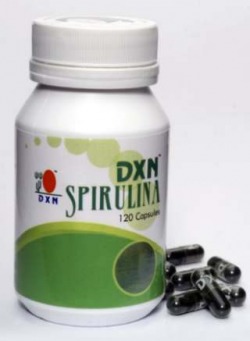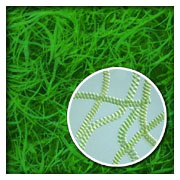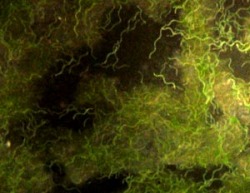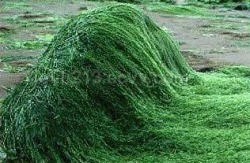What is spirulina?
Spirulina belongs to a class of cyanobacteria, or blue-green algae that grows in warm, alkaline, fresh water. The name spirulina is derived from the Latin word for ‘helix’ or spiral, which describes the swirling characteristics of this algae. Blue-green algae is believed by anthropologists and biologists to be the oldest living plant on the planet and a kind of primitive food, as they have been around for more than 3.5 billion years. As a single cell food form at the lowest level of the food chain, algae is believed to supply 90% of the world’s oxygen and possibly 90% of its food. Ancient records show that human beings have been using blue-green algae as an important food source for the last four thousand years. While the Chinese utilise it as a herb to treat vitamin deficiencies, the mayans, Aztecs and African natives eat it freshly harvested or as algae cakes. Spirulina started to gain popularity only in the last thirty years as a high-nutrient food supplement.
What makes spirulina so special?
Spirulina’s deep green colour comes from its rainbow of natural pigments - chlorophyll (green),
phycocyanin (blue) and carotenoids (yellow and orange). These pigments harvest the sun's energy at different wavelengths for the process called photosynthesis. What makes spirulina different from other plant forms is its tendency to absorb high amounts of sunlight, as it usually grows in very hot climates at high altitudes. As a result, it contains high energy levels from the sun. This is why some traditional practitioners refer to spirulina as a life force energy with a powerful healing and rejuvenative effect on the human body, mind and spirit.
Why is spirulina called Superfood by the World Health Organization?
The modern diet is far less nutritious than before. Excessive farming methods over-processing of foods strip them of their natural nutrients even before they reach our dinner table. Growing dependence on fast and processed foods, which are nutritionally empty, also leave us vulnerable to poor health and low energy levels. Even before scientific data was available, spirulina had been used since ancient times as a powerful source of nutrients and as an energy booster, antioxidant, antiviral, weight loss aid and lipid-lowering agent. Sprulina is now referred to as a Superfood because scientists have discovered it to contain all the important sources of nutrients such as:
The full spectrum of vitamins and minerals
Over 2000 enzymes
All the essential amino acids in the correct proportion
Omega-3 and 6 fatty acids
Antioxidant beta carotene
Glycolipids and sulfonolipids
High levels of iron and magnesium
As spirulina is 60% vegetable protein, it is easily digestible. It is believed to contain 20 times more protein than soybeans and 200 times more protein than beef. Spirulina is also second only to mother's milk in concentrations of natural gamma linolenic acid (GLA) and also contains natural substances called phycocyanin and long-chained sugars called polysacharrides, which strengthens the immune system. In short, it contains all the important nutrients necessary for good health and vitality, making it a Superfood
Who should take spirulina?
Almost everyone will benefit from taking spirulina as a wholesome food supplement, to increase general health and prevent disease. For some people, there is a stronger need than others, possibly due to:
1. Unhealthy lifestyles- Long-term effects of a poor diet due to stress, lack of time or heavy workload
2. Recuperation from surgery or illness- When the body needs more nutrients to return to its normal condition
2. High energy output- These include athletes, frequent travelers, highly stressed people, students
facing exams and others
3. Pregnancy and breastfeeding- Helps prevent iron deficiency and builds milk supply
4. Old age- Spirulina is easily digested and absorbed into the bloodstream
5. Vegetarian diets- High protein content is a great substitute for meat and diary protein
6. Weight-watching- Ensures sufficient nutrient intake when the body is abstaining from high fat and high calorie foods
7. Travelling- A valuable source of greens when fresh vegetables are not safe to be consumed or easily available
One of the oldest foods on the planet is now perfect for the high-tech future.
Spirulina is now accepted as such a nutrient-dense super food, it has been approved as space food by NASA and other long-term agencies for space travel and long-term space living.
Now one of the oldest foods on the planet is proving to be perfect for the high-tech future. And, because it is a single-celled plant, it assimilates with almost no work from your digestion. In fact, your body begins to assimilate it right in your mouth and into your bloodstream.
Spirulina is one of the many blue-green algaes (single-celled plants); named after its spiral shape. Algaes are incredibly old life forms, responsible for producing and sustaining our oxygenated atmosphere. They are the basis of the food chain and the primary source of food for the great baleen whales. Spirulina is not a salt-water algae; it grows in fresh inland waters. Due to being a prehistoric plant it is rich in nutrients and gives huge amounts of energy. The spirulina in Superfood is potentially one of the most concentrated, nutritious foods on this planet. It is the highest natural source of complete protein. The spirulina we use is very special and comes from Hawaii and is not found in many places in the world. Dr. Schulze's spirulina is grown in confined ponds, free from any other species of algae. This confinement means that no cross contamination from other species can take place this ensures that no microtoxins
can contaminate the spirulina. The water in which this spirulina grows is drawn through a deep pipeline from its origins 2000 feet below water level. The water is kept free of anything that could pollute the spirulina and therefore problems that have arisen in lake grown spirulina are simply not encountered. The high amount of sunshine makes the spirulina high in Beta Carotene. It is a rich source of B vitamins, especially B12 and it is also one of the richest sources of minerals. One of the oldest types of algae, it has a soft cell wall making digestion and assimilation exceptionally easy. Spirulina contains chelated versions of potassium, calcium, magnesium, zinc, selenium, phosphorous, and iron. In addition to these beneficial minerals, you can get your B-complex, A and E vitamins from spirulina. Spirulina also has all nine of the essential amino acids, as well as nine more nonessential ones. Spirulina contains compounds like phycocyanin, polysaccharides and sulfolipids that enhance the immune system. In fact spirulina contains the most remarkable concentration of functional nutrients ever known in any food, plant, grain or herb. No other algae, blue-green or chlorella, has been the subject of such intense research over the past 30 years - there have been thousands of scientific studies. Spirulina contains the major long-chain omega-3 fatty acid found in the brain. It is the primary building block of the gray matter of the brain and the retina of the eye. Spirulina is a rich source Gamma Linolenic Acid (GLA), which is the "miracle" ingredient of Spirulina. GLA is an essential fatty acid that has been shown very helpful in the relief of arthritis. GLA also helps lower high blood pressure and blood cholesterol. It eases such other conditions as premenstrual pain, eczema and other skin conditions. It is 58 times richer in organic iron than raw spinach and 28 times richer than raw beef liver! Phycocyanin, which is the natural blue pigment of Spirulina, is not found in any other food on the plant. Phycocyanin has shown promise in treating cancer in animals. It also stimulates the immune system.
Spirulina is Alkaline and Helps Balance your Body's pH
It is important that we maintain a balanced body pH of ideally around 7.2-7.4, which is roughly neutral. A diet of junk food to include fast food, over-cooked, processed foods, (especially soft drinks (the worst is cola), which have a pH of 2.7) creates a body that is several thousand times more acidic than our bodies. This is important because all diseases start and live and thrive in an acidic environment and do not live well in an alkaline environment. Thus it follows that to keep ourselves as alkaline as possible creating a healthy body. (Becoming too alkaline is rare but not unheard of.) The rise of fast, junk and processed foods match those of rising cancer rates. Thirty years ago, cancer in children was almost unheard of. Now they have entire hospital wards given over to children with cancer. We are too acidic! This is one of the many reasons why we are getting sick!
Spirulina is now accepted as such a nutrient-dense super food, it has been approved as space food by NASA and other long-term agencies for space travel and long-term space living.
Now one of the oldest foods on the planet is proving to be perfect for the high-tech future. And, because it is a single-celled plant, it assimilates with almost no work from your digestion. In fact, your body begins to assimilate it right in your mouth and into your bloodstream.
Spirulina is one of the many blue-green algaes (single-celled plants); named after its spiral shape. Algaes are incredibly old life forms, responsible for producing and sustaining our oxygenated atmosphere. They are the basis of the food chain and the primary source of food for the great baleen whales. Spirulina is not a salt-water algae; it grows in fresh inland waters. Due to being a prehistoric plant it is rich in nutrients and gives huge amounts of energy. The spirulina in Superfood is potentially one of the most concentrated, nutritious foods on this planet. It is the highest natural source of complete protein. The spirulina we use is very special and comes from Hawaii and is not found in many places in the world. Dr. Schulze's spirulina is grown in confined ponds, free from any other species of algae. This confinement means that no cross contamination from other species can take place this ensures that no microtoxins
can contaminate the spirulina. The water in which this spirulina grows is drawn through a deep pipeline from its origins 2000 feet below water level. The water is kept free of anything that could pollute the spirulina and therefore problems that have arisen in lake grown spirulina are simply not encountered. The high amount of sunshine makes the spirulina high in Beta Carotene. It is a rich source of B vitamins, especially B12 and it is also one of the richest sources of minerals. One of the oldest types of algae, it has a soft cell wall making digestion and assimilation exceptionally easy. Spirulina contains chelated versions of potassium, calcium, magnesium, zinc, selenium, phosphorous, and iron. In addition to these beneficial minerals, you can get your B-complex, A and E vitamins from spirulina. Spirulina also has all nine of the essential amino acids, as well as nine more nonessential ones. Spirulina contains compounds like phycocyanin, polysaccharides and sulfolipids that enhance the immune system. In fact spirulina contains the most remarkable concentration of functional nutrients ever known in any food, plant, grain or herb. No other algae, blue-green or chlorella, has been the subject of such intense research over the past 30 years - there have been thousands of scientific studies. Spirulina contains the major long-chain omega-3 fatty acid found in the brain. It is the primary building block of the gray matter of the brain and the retina of the eye. Spirulina is a rich source Gamma Linolenic Acid (GLA), which is the "miracle" ingredient of Spirulina. GLA is an essential fatty acid that has been shown very helpful in the relief of arthritis. GLA also helps lower high blood pressure and blood cholesterol. It eases such other conditions as premenstrual pain, eczema and other skin conditions. It is 58 times richer in organic iron than raw spinach and 28 times richer than raw beef liver! Phycocyanin, which is the natural blue pigment of Spirulina, is not found in any other food on the plant. Phycocyanin has shown promise in treating cancer in animals. It also stimulates the immune system.
Spirulina is Alkaline and Helps Balance your Body's pH
It is important that we maintain a balanced body pH of ideally around 7.2-7.4, which is roughly neutral. A diet of junk food to include fast food, over-cooked, processed foods, (especially soft drinks (the worst is cola), which have a pH of 2.7) creates a body that is several thousand times more acidic than our bodies. This is important because all diseases start and live and thrive in an acidic environment and do not live well in an alkaline environment. Thus it follows that to keep ourselves as alkaline as possible creating a healthy body. (Becoming too alkaline is rare but not unheard of.) The rise of fast, junk and processed foods match those of rising cancer rates. Thirty years ago, cancer in children was almost unheard of. Now they have entire hospital wards given over to children with cancer. We are too acidic! This is one of the many reasons why we are getting sick!




